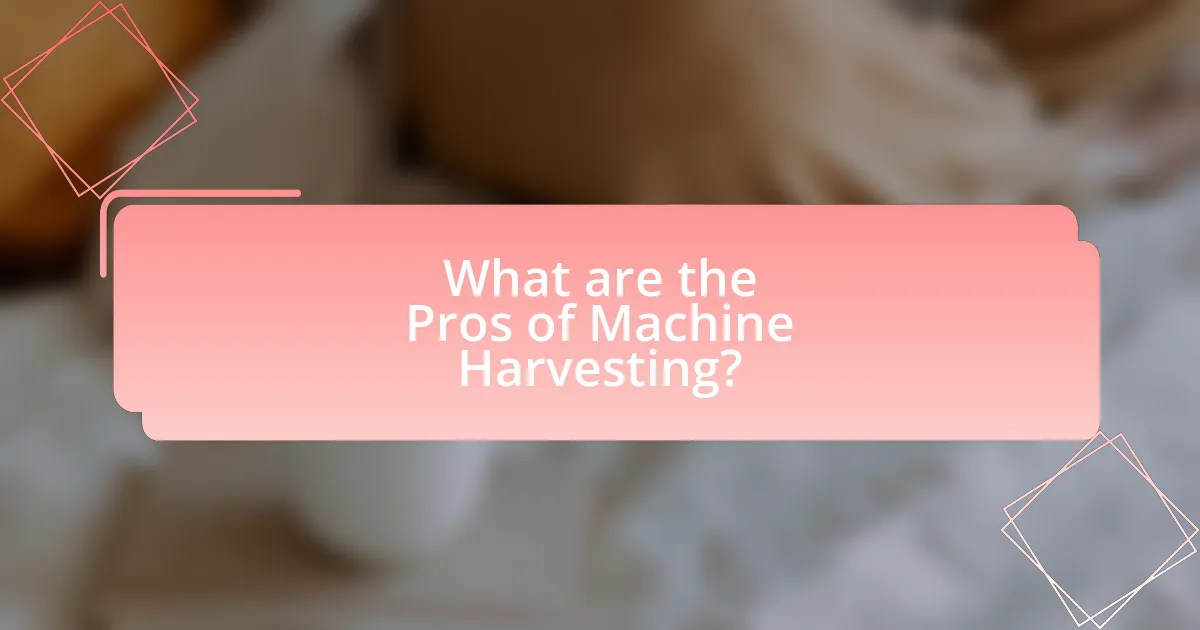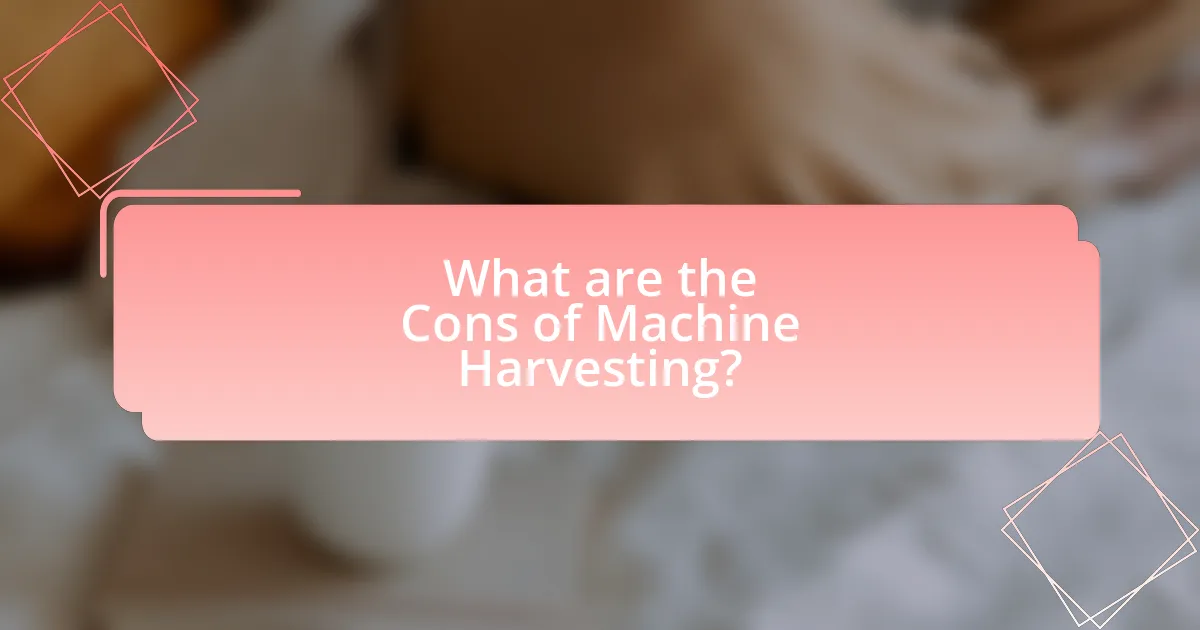The article examines the two primary methods of crop harvesting: hand-picking and machine harvesting, highlighting their respective advantages and disadvantages. Hand-picking is characterized by careful manual collection, ensuring high-quality produce with minimal damage, making it ideal for delicate crops. In contrast, machine harvesting offers increased efficiency and reduced labor costs, suitable for larger-scale operations but often at the expense of crop quality. The article further explores the historical context, technological advancements, economic implications, and environmental impacts associated with each method, providing a comprehensive analysis to aid farmers in making informed decisions based on crop type, labor availability, and cost-effectiveness.

What are Hand-Picking and Machine Harvesting?
Hand-picking refers to the manual collection of crops by individuals, ensuring careful selection and minimal damage to the produce. This method is often employed for delicate fruits and vegetables, where quality is paramount. Machine harvesting, on the other hand, involves the use of specialized machinery to gather crops efficiently and quickly, significantly increasing the volume harvested in a shorter time frame. This method is commonly used for larger-scale farming operations, particularly for crops like grains and certain fruits, where speed and cost-effectiveness are critical. The choice between hand-picking and machine harvesting often depends on factors such as crop type, labor availability, and economic considerations.
How do Hand-Picking and Machine Harvesting differ in practice?
Hand-picking and machine harvesting differ primarily in the method of collecting crops. Hand-picking involves human laborers manually selecting and gathering fruits or vegetables, which allows for careful handling and selection of ripe produce. In contrast, machine harvesting utilizes specialized equipment to mechanically collect crops, significantly increasing efficiency and speed, but often at the cost of potential damage to the produce and soil. For example, studies show that hand-picking can reduce bruising and improve quality for delicate fruits like berries, while machine harvesting is more suited for robust crops like corn or wheat, where speed and volume are prioritized.
What techniques are used in Hand-Picking?
Hand-picking employs techniques such as selective harvesting, manual inspection, and careful handling of crops. Selective harvesting involves choosing only ripe or high-quality fruits or vegetables, ensuring optimal yield and quality. Manual inspection allows workers to assess the condition of each item, identifying any defects or diseases that may not be visible through machine harvesting. Careful handling minimizes damage to the produce, preserving its market value. These techniques are particularly effective in crops like berries and delicate fruits, where quality is paramount.
What technologies are involved in Machine Harvesting?
Machine harvesting involves several key technologies, including automated harvesting machines, GPS technology, and sensors. Automated harvesting machines, such as combine harvesters, are designed to efficiently gather crops by cutting, threshing, and separating grain from chaff in a single operation. GPS technology enhances precision in navigation and field mapping, allowing for optimized routes and reduced crop damage. Additionally, sensors are utilized to monitor crop conditions and adjust harvesting techniques in real-time, improving efficiency and yield. These technologies collectively enable faster and more efficient harvesting compared to traditional hand-picking methods.
What are the historical contexts of Hand-Picking and Machine Harvesting?
Hand-picking and machine harvesting have distinct historical contexts that reflect the evolution of agricultural practices. Hand-picking dates back to ancient agricultural societies, where manual labor was the primary method for gathering crops, emphasizing the labor-intensive nature of early farming. In contrast, machine harvesting emerged during the Industrial Revolution in the 19th century, driven by technological advancements that aimed to increase efficiency and reduce labor costs. The introduction of mechanical harvesters, such as the reaper invented by Cyrus McCormick in 1831, revolutionized crop collection, allowing farmers to harvest larger areas in significantly less time. This shift from hand-picking to machine harvesting marked a significant transformation in agricultural productivity and labor dynamics, as mechanization began to replace traditional farming methods.
How has Hand-Picking evolved over time?
Hand-picking has evolved from a traditional agricultural practice reliant on manual labor to a more refined technique that incorporates modern tools and methods. Initially, hand-picking was the primary method for harvesting crops, emphasizing skill and labor intensity, particularly in fruit and vegetable production. Over time, advancements in agricultural practices, such as the introduction of ergonomic tools and improved training techniques, have enhanced efficiency and reduced physical strain on workers. Additionally, the integration of technology, such as mobile apps for tracking harvest quality and timing, has further transformed hand-picking into a more systematic approach. Historical data indicates that while hand-picking remains labor-intensive, its evolution has allowed for better quality control and increased productivity, particularly in high-value crops where precision is essential.
What advancements have influenced Machine Harvesting?
Advancements in machine harvesting have been significantly influenced by technological innovations such as automation, sensor technology, and artificial intelligence. Automation has enabled the development of sophisticated harvesting machinery that can operate with minimal human intervention, increasing efficiency and reducing labor costs. Sensor technology allows machines to detect crop ripeness and optimize harvesting timing, which enhances yield quality. Additionally, artificial intelligence algorithms improve decision-making processes in harvesting operations by analyzing data for better resource management. These advancements collectively contribute to more efficient, precise, and cost-effective harvesting practices in agriculture.

What are the Pros of Hand-Picking?
The pros of hand-picking include higher quality produce, reduced damage to crops, and the ability to selectively harvest ripe fruits. Hand-picking allows workers to choose only the best fruits, ensuring that only the highest quality products reach consumers. This method minimizes bruising and damage, which is often caused by mechanical harvesting, leading to better preservation of the produce. Additionally, hand-picking enables workers to identify and harvest only those fruits that are at peak ripeness, which can enhance flavor and market value. Studies have shown that hand-harvested crops often yield better quality and taste compared to those harvested by machines.
How does Hand-Picking benefit crop quality?
Hand-picking enhances crop quality by allowing for selective harvesting, which ensures that only ripe and undamaged produce is collected. This method reduces the likelihood of bruising and spoilage, as workers can carefully assess each item for optimal ripeness and quality. Studies have shown that hand-picked fruits and vegetables often have superior taste and texture compared to those harvested by machines, as the latter can cause mechanical damage and mix unripe or overripe produce. Additionally, hand-picking minimizes the risk of contamination, as workers can maintain hygiene standards more effectively than machines, further contributing to the overall quality of the crop.
What impact does Hand-Picking have on fruit ripeness?
Hand-picking significantly impacts fruit ripeness by allowing for the selection of only fully ripe fruits, which enhances quality and flavor. This method enables harvesters to assess each fruit’s ripeness based on visual and tactile cues, ensuring that only those at optimal maturity are collected. Research indicates that hand-picked fruits often have better taste and texture compared to those harvested by machines, which may pick fruits at varying stages of ripeness, leading to inconsistent quality.
How does Hand-Picking reduce damage to crops?
Hand-picking reduces damage to crops by allowing for selective harvesting, which minimizes the risk of bruising and breaking plants. This method enables workers to carefully choose ripe fruits or vegetables, avoiding those that are underdeveloped or damaged. Research indicates that hand-harvested crops experience significantly lower rates of physical damage compared to machine-harvested crops, which can cause more extensive bruising and loss due to their mechanical nature. For instance, studies have shown that hand-harvesting can reduce fruit damage rates by up to 30% compared to mechanical methods, thereby preserving crop quality and yield.
What are the economic advantages of Hand-Picking?
Hand-picking offers significant economic advantages, primarily through reduced labor costs and increased product quality. By employing skilled labor for selective harvesting, producers can minimize waste and ensure that only the best fruits or vegetables are collected, which can lead to higher market prices. For instance, studies have shown that hand-picked crops often fetch prices up to 30% higher than those harvested by machines due to their superior quality and reduced damage. Additionally, hand-picking can be more cost-effective in smaller farms or regions with uneven terrain where machinery may not be feasible, allowing farmers to optimize their resources and maintain profitability.
How does Hand-Picking affect labor costs?
Hand-picking increases labor costs due to the higher number of workers required for manual harvesting compared to machine harvesting. This method necessitates a larger workforce to cover the same area, as each worker can only harvest a limited amount of produce in a given time. For instance, studies have shown that hand-picking can cost up to three times more per acre than machine harvesting, primarily because of the wages paid to laborers and the time-intensive nature of the task. Additionally, labor costs can further escalate during peak harvest seasons when demand for workers increases, leading to higher wage rates.
What is the market demand for Hand-Picked produce?
The market demand for hand-picked produce is increasing due to consumer preferences for quality and sustainability. Research indicates that 70% of consumers are willing to pay a premium for hand-picked fruits and vegetables, as they perceive them to be fresher and more flavorful compared to machine-harvested options. Additionally, the rise of organic and local food movements has further fueled this demand, with hand-picked produce often being associated with these trends.

What are the Cons of Hand-Picking?
The cons of hand-picking include higher labor costs, slower harvesting speed, and potential for inconsistent quality. Labor costs are significantly elevated because hand-picking requires a larger workforce compared to machine harvesting, which can automate the process. The slower harvesting speed means that hand-picking can lead to delays in getting crops to market, impacting freshness and profitability. Additionally, the quality of hand-picked produce can vary based on the skill and attention of individual workers, leading to inconsistencies that may affect marketability.
What challenges does Hand-Picking present?
Hand-picking presents several challenges, primarily related to labor intensity and efficiency. The process requires a significant amount of manual labor, which can lead to higher operational costs and potential labor shortages, especially during peak harvest seasons. Additionally, hand-picking is time-consuming, often resulting in slower harvesting rates compared to machine harvesting. This inefficiency can affect the overall productivity of agricultural operations, particularly for large-scale farms. Furthermore, the reliance on skilled labor can introduce variability in the quality of the harvest, as inexperienced workers may not select the best produce.
How does labor availability affect Hand-Picking?
Labor availability directly impacts hand-picking by determining the efficiency and feasibility of manual harvesting operations. When labor is abundant, hand-picking can be performed more effectively, allowing for timely harvesting of crops, which is crucial for maintaining quality and reducing waste. Conversely, limited labor availability can lead to delays in harvesting, increased labor costs, and potential loss of crop quality due to over-ripening or spoilage. For instance, in regions where labor shortages are prevalent, farmers may struggle to find enough workers, resulting in a shift towards machine harvesting despite its higher initial costs. This relationship highlights the critical role of labor supply in the viability of hand-picking as a harvesting method.
What are the limitations of Hand-Picking in large-scale farming?
Hand-picking in large-scale farming is limited by its labor intensity, inefficiency, and high costs. The process requires a significant workforce, which can lead to labor shortages and increased wages, making it economically unfeasible for large operations. Additionally, hand-picking is time-consuming, resulting in slower harvests compared to machine harvesting, which can cover larger areas in a fraction of the time. Studies indicate that machine harvesting can increase productivity by up to 50% compared to manual methods, highlighting the inefficiency of hand-picking in large-scale contexts. Furthermore, the quality of the harvest may vary with hand-picking, as it relies heavily on the skill and speed of individual workers, leading to inconsistent results.
What are the environmental impacts of Hand-Picking?
Hand-picking has minimal environmental impacts compared to machine harvesting. This method reduces soil compaction and erosion, as it does not require heavy machinery that can damage the land. Additionally, hand-picking allows for selective harvesting, which helps maintain biodiversity by preserving non-target plants and minimizing habitat disruption. Studies indicate that hand-picking can lead to healthier ecosystems, as it promotes the growth of native species and reduces the need for chemical interventions, such as pesticides and fertilizers, which can harm surrounding wildlife.
How does Hand-Picking influence soil health?
Hand-picking positively influences soil health by minimizing soil compaction and preserving soil structure. Unlike machine harvesting, which can lead to soil disturbance and compaction, hand-picking allows for careful selection of crops without heavy machinery, thus maintaining the integrity of the soil ecosystem. Studies have shown that reduced soil compaction enhances water infiltration and root growth, leading to healthier plants and improved soil microbial activity. This method also allows for the preservation of beneficial organisms in the soil, which are crucial for nutrient cycling and overall soil fertility.
What are the sustainability concerns related to Hand-Picking?
Sustainability concerns related to hand-picking include labor intensity, potential for worker exploitation, and environmental impact. Hand-picking requires significant human labor, which can lead to overwork and inadequate compensation for workers, particularly in regions with weak labor laws. Additionally, the practice may contribute to soil degradation and habitat disruption if not managed properly, as repeated hand-picking in the same areas can lead to erosion and loss of biodiversity. Studies indicate that while hand-picking can be less damaging than some mechanical methods, it still poses risks to both social and environmental sustainability if not conducted under fair labor practices and with ecological considerations.

What are the Pros of Machine Harvesting?
Machine harvesting offers several advantages, including increased efficiency, reduced labor costs, and the ability to harvest crops in a timely manner. The use of machinery allows for the rapid collection of large quantities of produce, significantly speeding up the harvesting process compared to manual methods. For instance, a study by the USDA found that machine harvesting can increase productivity by up to 50% in certain crops, such as corn and soybeans. Additionally, machine harvesting minimizes the need for manual labor, which can be costly and difficult to source, especially during peak harvest times. This efficiency not only lowers operational costs but also helps ensure that crops are harvested at their optimal ripeness, reducing waste and improving overall yield quality.
How does Machine Harvesting enhance efficiency?
Machine harvesting enhances efficiency by significantly increasing the speed and volume of crop collection compared to manual methods. This technology allows for the rapid gathering of large quantities of produce, reducing labor costs and time spent in the field. For instance, a study by the USDA found that machine harvesting can increase productivity by up to 50% compared to hand-picking, enabling farmers to cover more ground in less time. Additionally, machines can operate continuously, further maximizing output during harvest seasons.
What is the impact of Machine Harvesting on harvest speed?
Machine harvesting significantly increases harvest speed compared to traditional hand-picking methods. Studies indicate that machine harvesters can operate at speeds of up to 10 times faster than manual labor, allowing for the completion of large-scale harvests in a fraction of the time. For example, a study published in the “Journal of Agricultural Engineering” found that machine harvesting of crops like corn and soybeans can reduce harvest time from several weeks to just a few days, enhancing overall efficiency and productivity in agricultural operations.
How does Machine Harvesting reduce labor dependency?
Machine harvesting reduces labor dependency by automating the collection of crops, significantly decreasing the need for manual labor. This technology allows for faster and more efficient harvesting processes, enabling farmers to cover larger areas in shorter timeframes. For instance, a study by the Food and Agriculture Organization (FAO) indicates that machine harvesting can increase productivity by up to 30%, thereby lessening reliance on seasonal labor forces. Additionally, the use of machines minimizes labor costs and mitigates challenges associated with labor shortages, particularly during peak harvest seasons.
What are the economic benefits of Machine Harvesting?
Machine harvesting significantly reduces labor costs and increases efficiency in agricultural production. By automating the harvesting process, farmers can save on wages and benefits associated with manual labor, which can account for up to 50% of total production costs in some crops. Additionally, machine harvesting allows for faster collection of crops, minimizing losses due to over-ripening or adverse weather conditions. For instance, studies have shown that mechanized harvesting can increase yield by up to 20% compared to hand-picking, as it enables timely harvesting of large areas. This efficiency translates into higher profitability for farmers, as they can allocate resources more effectively and respond quickly to market demands.
How does Machine Harvesting affect production costs?
Machine harvesting significantly reduces production costs by increasing efficiency and decreasing labor expenses. The use of machinery allows for faster harvesting, which can lead to lower operational costs per unit of produce. For instance, studies have shown that machine harvesting can reduce labor costs by up to 50% compared to manual harvesting methods. Additionally, machinery can operate in various weather conditions and harvest crops more consistently, minimizing losses and maximizing yield. This efficiency translates into lower overall production costs, making machine harvesting a financially advantageous choice for many agricultural operations.
What is the return on investment for Machine Harvesting technology?
The return on investment for Machine Harvesting technology can be substantial, often exceeding 200% within the first few years of implementation. This high ROI is primarily due to reduced labor costs, increased efficiency, and the ability to harvest crops faster than traditional hand-picking methods. For instance, a study by the University of California found that machine harvesting can reduce labor costs by up to 50% while increasing the speed of harvest by 30%, leading to significant savings and higher yields.

What are the Cons of Machine Harvesting?
The cons of machine harvesting include reduced crop quality, increased initial investment costs, and potential job loss for manual laborers. Machine harvesting can lead to damage of delicate crops, resulting in lower quality produce, as evidenced by studies showing that mechanical methods can bruise or crush fruits and vegetables. Additionally, the upfront costs for purchasing and maintaining harvesting machinery can be significant, often deterring smaller farms from adopting this technology. Furthermore, the automation of harvesting processes can lead to job displacement, as fewer workers are needed for harvesting tasks, impacting local employment rates in agricultural communities.
What are the potential downsides of using machines for harvesting?
The potential downsides of using machines for harvesting include increased initial costs, reduced job opportunities for manual laborers, and potential damage to crops. The initial investment in harvesting machinery can be substantial, often requiring significant capital that may not be feasible for smaller farms. Additionally, the automation of harvesting processes can lead to a decrease in available jobs for seasonal workers, impacting local economies that rely on agricultural employment. Furthermore, machines may not be as gentle as hand-picking, leading to bruising or damage to delicate crops, which can affect overall quality and marketability.
How does Machine Harvesting impact crop quality?
Machine harvesting can negatively impact crop quality due to increased mechanical damage and reduced selectivity. The use of machinery often leads to bruising and crushing of fruits or vegetables, which can compromise their appearance and shelf life. Studies indicate that mechanical harvesting can result in a higher percentage of damaged produce compared to hand-picking, where workers can selectively harvest only the ripe or undamaged items. For instance, research published in the Journal of Agricultural Engineering found that mechanical harvesting of tomatoes resulted in a 15% increase in bruising compared to hand-harvested tomatoes. This evidence highlights the potential drawbacks of machine harvesting on the overall quality of crops.
What are the risks of mechanical damage to crops?
Mechanical damage to crops can lead to significant yield loss and reduced quality. This damage often occurs during harvesting, where machinery can bruise, cut, or crush plants, resulting in physical injuries that make crops more susceptible to diseases and pests. For instance, studies have shown that mechanical harvesting can cause up to a 30% reduction in yield for certain fruits due to bruising and other injuries. Additionally, mechanical damage can lead to increased post-harvest losses, as damaged crops are more likely to spoil or decay.
What are the environmental concerns associated with Machine Harvesting?
Machine harvesting raises several environmental concerns, primarily related to soil degradation, biodiversity loss, and increased carbon emissions. The heavy machinery used in harvesting can compact soil, reducing its aeration and water retention capabilities, which negatively impacts plant growth and soil health. Additionally, machine harvesting often leads to habitat destruction, as large areas of land are cleared for equipment access, disrupting local ecosystems and threatening wildlife. Furthermore, the reliance on fossil fuels for operating machinery contributes to greenhouse gas emissions, exacerbating climate change. Studies indicate that these practices can lead to a significant decline in local flora and fauna, highlighting the need for more sustainable harvesting methods.
How does Machine Harvesting affect biodiversity?
Machine harvesting negatively affects biodiversity by disrupting ecosystems and reducing species diversity. The use of large machinery can lead to habitat destruction, soil compaction, and the removal of non-target species, which diminishes the overall health of the environment. Studies indicate that areas subjected to machine harvesting often experience a decline in native plant and animal populations, as the mechanical processes can eliminate critical habitats and food sources. For example, research published in the journal “Ecological Applications” highlights that intensive agricultural practices, including machine harvesting, can lead to a 30% reduction in local biodiversity compared to traditional hand-picking methods.
What are the implications of fuel consumption in Machine Harvesting?
Fuel consumption in machine harvesting significantly impacts operational costs and environmental sustainability. High fuel usage increases the overall expenses for farmers, as fuel prices fluctuate and can constitute a large portion of the total harvesting costs. For instance, studies indicate that fuel costs can account for up to 30% of the total operational expenses in large-scale farming operations. Additionally, increased fuel consumption contributes to higher greenhouse gas emissions, which raises concerns about the environmental footprint of agricultural practices. This dual impact of economic and ecological factors underscores the importance of optimizing fuel efficiency in machine harvesting to enhance both profitability and sustainability.
How can farmers choose between Hand-Picking and Machine Harvesting?
Farmers can choose between hand-picking and machine harvesting by evaluating factors such as crop type, labor availability, and cost-effectiveness. Hand-picking is often preferred for delicate crops like berries, where damage from machinery can lead to significant losses, while machine harvesting is more efficient for larger-scale operations with robust crops like corn or wheat. According to a study by the USDA, machine harvesting can reduce labor costs by up to 50% for certain crops, making it a financially viable option for many farmers. Additionally, farmers should consider the initial investment in machinery versus the ongoing costs of labor, as well as the potential yield and quality of the harvested produce.
What factors should influence the decision-making process?
The factors that should influence the decision-making process in the context of hand-picking versus machine harvesting include cost efficiency, labor availability, crop type, and quality requirements. Cost efficiency is critical as machine harvesting typically reduces labor costs and increases speed, while hand-picking may be more expensive but can ensure higher quality for delicate crops. Labor availability is another significant factor; regions with a shortage of labor may favor machine harvesting. The type of crop also plays a role; certain crops are better suited for machine harvesting due to their resilience, while others require the precision of hand-picking. Lastly, quality requirements must be considered, as some markets demand higher quality that hand-picking can provide, impacting the overall decision.
How can farmers assess the suitability of each method for their crops?
Farmers can assess the suitability of hand-picking versus machine harvesting methods for their crops by evaluating factors such as crop type, labor availability, cost-effectiveness, and the specific harvesting requirements of the crops. For instance, delicate crops like berries often require hand-picking to prevent damage, while robust crops like corn can be efficiently harvested using machines. Additionally, farmers should consider the economic implications; machine harvesting may incur higher initial costs but can reduce labor expenses over time. Research indicates that machine harvesting can increase efficiency by up to 50% for certain crops, making it a viable option when labor is scarce or expensive. Thus, a thorough analysis of these factors will enable farmers to make informed decisions regarding the most suitable harvesting method for their specific crop needs.


